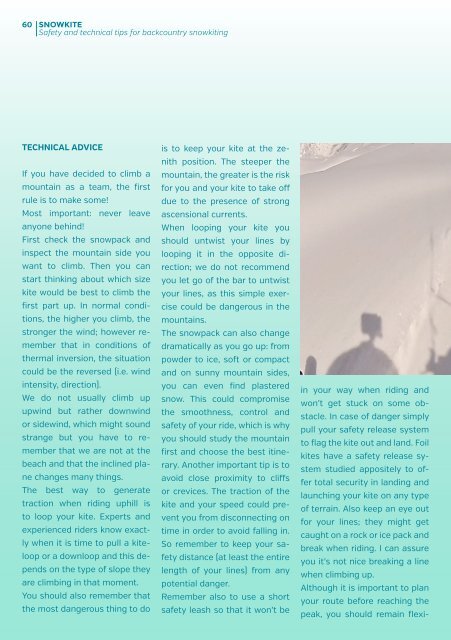Create successful ePaper yourself
Turn your PDF publications into a flip-book with our unique Google optimized e-Paper software.
60SNOWKITESafety and technical tips for backcountry snowkitingTECHNICAL ADVICEIf you have decided to climb amountain as a team, the firstrule is to make some!Most important: never leaveanyone behind!First check the snowpack andinspect the mountain side youwant to climb. Then you canstart thinking about which sizekite would be best to climb thefirst part up. In normal conditions,the higher you climb, thestronger the wind; however rememberthat in conditions ofthermal inversion, the situationcould be the reversed (i.e. windintensity, direction).We do not usually climb upupwind but rather downwindor sidewind, which might soundstrange but you have to rememberthat we are not at thebeach and that the inclined planechanges many things.The best way to generatetraction when riding uphill isto loop your kite. Experts andexperienced riders know exactlywhen it is time to pull a kiteloopor a downloop and this dependson the type of slope theyare climbing in that moment.You should also remember thatthe most dangerous thing to dois to keep your kite at the zenithposition. The steeper themountain, the greater is the riskfor you and your kite to take offdue to the presence of strongascensional currents.When looping your kite youshould untwist your lines bylooping it in the opposite direction;we do not recommendyou let go of the bar to untwistyour lines, as this simple exercisecould be dangerous in themountains.The snowpack can also changedramatically as you go up: frompowder to ice, soft or compactand on sunny mountain sides,you can even find plasteredsnow. This could compromisethe smoothness, control andsafety of your ride, which is whyyou should study the mountainfirst and choose the best itinerary.Another important tip is toavoid close proximity to cliffsor crevices. The traction of thekite and your speed could preventyou from disconnecting ontime in order to avoid falling in.So remember to keep your safetydistance (at least the entirelength of your lines) from anypotential danger.Remember also to use a shortsafety leash so that it won’t bein your way when riding andwon’t get stuck on some obstacle.In case of danger simplypull your safety release systemto flag the kite out and land. Foilkites have a safety release systemstudied appositely to offertotal security in landing andlaunching your kite on any typeof terrain. Also keep an eye outfor your lines; they might getcaught on a rock or ice pack andbreak when riding. I can assureyou it’s not nice breaking a linewhen climbing up.Although it is important to planyour route before reaching thepeak, you should remain flexi-


















